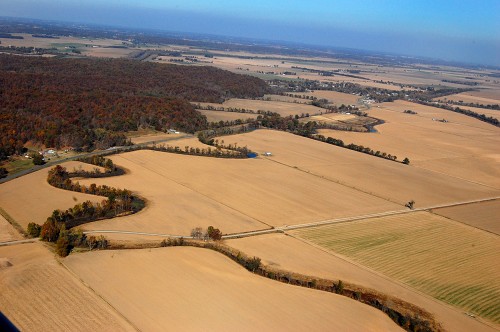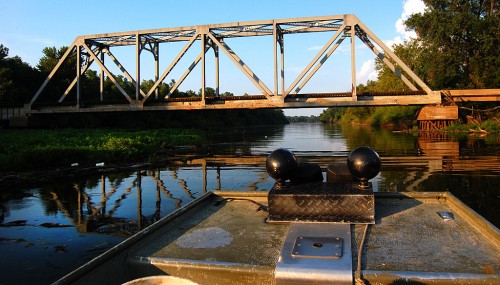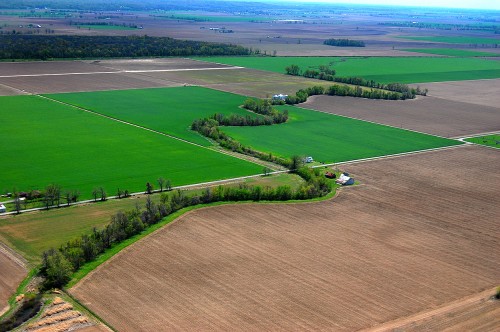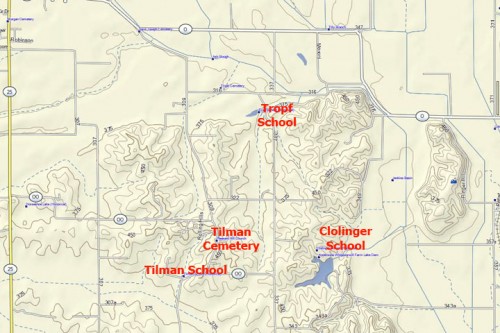 Keith Lewis had a story in The Missourian October 4 noting that work on the Little River Drainage District started 100 years ago. There was a good reason why old-timers refer to this area as Swampeast Missouri: a large portion of Southeast Missouri was nothing but nearly impenetrable swamps with names like the Dark Cypress, Old Field and Big Field.
Keith Lewis had a story in The Missourian October 4 noting that work on the Little River Drainage District started 100 years ago. There was a good reason why old-timers refer to this area as Swampeast Missouri: a large portion of Southeast Missouri was nothing but nearly impenetrable swamps with names like the Dark Cypress, Old Field and Big Field.
This aerial photo was taken south and west of Delta and shows the old Whitewater River meandering through what once would have been swamp. Dad had a job to divert the river, essentially cutting off this channel years and years ago.
Miles and miles of farmland
Once the timber was logged off and the land cleared, it turned out to be incredibly rich for farming.
Cut trees when swamp froze over
I interviewed Wife Lila’s Uncle Ray Seyer a couple of years ago when he was 89. Ray remembers growing up in the Tillman community area and hearing stories from his dad about the old days. “Pop would ride a horse – no cars in those days – from Kelso down through Delta and most of the time the water was up to the horse’s belly.”
“When they started clearing that ground there – it was all wooded area – they couldn’t cut when that water was in there.. they’d wait until it froze over, then cut it above the ice and let it float out later.”
Soft ground could swallow a tractor
Ray told some stories I had heard from old-timers back when I was a kid. I’m hoping I can run across a tape recording I made of one of Mother’s friends describing putting 12″ x 12″ “mudshoes” on horses to keep them from sinking into the “sinky” muck.
Ray and Dad both said you’d better not stop once you started across the old swamp. Ray talked about a couple of guys who used to haul limestone out of there. Their Caterpillar-type tractor stalled out at the end of the workday and wouldn’t start. They decided to leave it until the morning. The next day, only two smokestacks were visible above the muck, he said.
Diversion Channel
 The Big Ditch is one of the main ways to move water out of the basin into the Mississippi River. Here are some of the stories I’ve done about the Diversion Channel.
The Big Ditch is one of the main ways to move water out of the basin into the Mississippi River. Here are some of the stories I’ve done about the Diversion Channel.
- Trotline Fishing at the mouth of the Diversion Channel
- A scenic ride down the Diversion Channel
- Allenville railroad bridge over the Diversion Channel
- Diversion Channel fish feeling the heat
- Mississippi River backs up into Diversion Channel
- Lester Harris swings over Big Ditch
- Dam pits neighbor against neighbor



Several years ago, I interviewed Lloyd Francis, who had a farm east of Advance in the Old Field. He showed me one of the pieces of wood that they nailed to the horses’ hooves to keep them from sinking. I seem to remember that they couldn’t use mules, because their hooves were too small. I can’t imagine a mule letting them nail wood to its hooves, anyway!
As I understand it, the water table in that area has gone down significantly over the years.
Surely a member of the Vandivort clan has a comment. Or the Harrison, Himelberger or Oliver folks.
Heck, although John didn’t tell J Fred everything, he still knows a lot.
Stories were all true. OUr farm was outisde Advance in the oldfield area. Even in my day it was tricky work using a tractor after a rain. We had cypress trees too, which of course are used to significant water. Also a hill which had been an indian camping ground – we found many artifacts of their presence.
My first job after graduating from MSM at Rolla, was with the Mo. Conservation Commission . One of the projects was the Duck Creek Project near Puxico. The old Diversion Ditch project by the Corps of Engineers drained all this area. The Duck Creek Project put 10,000 acres back into swamp by building new levees and diverting Caster River into that area for re-establishing the swamp for hunting and fishing purposes. What goes around comes around! Dad used to talk about catching the old Houke(sp) RR into that area when it was the Mingo Swamp for those same purposes.
My first job after graduating from MSM at Rolla, was with the Mo. Conservation Commission . One of the projects was the Duck Creek Project near Puxico. The old Diversion Ditch project by the Corps of Engineers drained all this area. The Duck Creek Project put 10,000 acres back into swamp by building new levees and diverting Caster River into that area for re-establishing the swamp for hunting and fishing purposes. What goes around comes around! Dad used to talk about catching the old Houke(sp) RR into that area when it was the Mingo Swamp for those same purposes.
The stories about sinking tractors os catapillers are true!
In 1974, Doug and I bought the Kochtitzky home in Malden. In the attic was a model of the dredge Otto Kochtitzky developed to move across the cypress swamp and dig the drainage ditches. It is now on display at the Malden Historical Museum.
I’m glad we still have the conservation areas in Southeast Missouri that are still swampland. I love duck hunting down there.
Fortunes were made cutting that swamp timber.
I remember SEMO biology teacher Paul Heye taking my class to some of the former swamp turned to farmland. At one point we all got out and stood together in a field. He asked the class to all jump together. The dark land rippled and quaked all around for quite a distance out.
Any one but me who has shot a “swamp rabbit”? I regret doing it now (near Greenbriar)… they are huge and I hope some still survive.
My great-grandfather, a fireman on the old Houck railroads, had said that when they started draining the swamps, the decaying material would build up enough heat that the ground would catch on fire. The run from Cape to Poplar Bluff was one of his jobs.
I like this website it is awesome and interesting
You will find that Ken Steinhoff has written about nearly EVERY conceivable aspect of life in Southeast Missouri! His footprints are all over this country!!
Interesting………the farm that LLoyd now owns did belong to Ford Groves Family. Lloyd is a first cousin to my husband. My husband’s family owns a farm across the road from Lloyd’s. There is so much humus in the soil that it can easily catch on fire………Through the years I have heard many interesting stories……..
MARY SEABAUGH FRANCIS
YES, I just discovered Ken’s stories………and one he has just brought tears of joy…
He just returned a soul after almost five decades.
This quote of his says it all.
“Doing this blog has taught me that I didn’t really ‘steal” the souls. I merely borrowed them for three, four or five decades. Now I’m returning them.”
I’m gone to convey my little brother, that he should also visit this weblog on regular basis to get updated from latest reports.
I just finished rereading this blog……still very interesting to read. My father-in-law owned several hundred acres….300 something I think belongs to the boys now……
When I was dating my future husband his mother would have a half gallon jar of homemade lemonade ready for me when I stopped by the house on my way home from SEMO. I would take my shoes off and go barefooted out to where Al was working to deliver him some ice cold lemonade. That black dirt stain was extremely hard to get off my feet. Great memories of times at the farm…..
I am searching for stories of before the draining of the Big Swamp. Historical stories of what the area was like. I would appreciate anything I can get.
My dad grew up on the east side of the “old field” as a farmer for Albert Painton Farms. Dad was a sharecropper and I still remember the stories of the mules or horses with 12 by 12 by 2 attached to the hooves for work in the old field. He also told a story of a dredge, (dragline as was called), that was cleaning out a ditch bottom that was left overnight on the ditch bank. Heavy rain, overnight caused it to slip into the ditch and the only part observed by the naked eye the next morning was about 2 ft of the Boom that could be seen.
Dad also had many stories of the wonderful hunting of ducks, squirrels, rabbits and swap rabbits.
His great uncle told him of stories across the swap (old field) of hearing wolves that would be howling at the moon. Another story was about sitting under a Hickory Nut Tree early in the fall on a crisp morning waiting for daylight. Hearing some noise of bark falling on his head, thinking he was going to get a shot at a squirrel with his favorite double barrel Hopkins and Allen 12 gauge shotgun. His surprise, amazement and later fear, was that it was actually a mountain lion that he killed with the gun.
Dad, Noble (1909-1980) was I storyteller and oh how I wish now I had paid better attention to those wonderful stories. now I only remember bits and pieces of many of them.
Robert Lee Hess or as I was known then by Bell City and Painton, friends and family Bobby Lee.
Another contributor to this site Madeline Dejournett was my high-school teacher.
I’ve heard bits and pieces of similar stories. I tape recorded some of them, but no telling which reel they are on and which box they are in. The amazing thing is that, historically speaking, the draining of SE MO wasn’t that long ago.
Hello Ken,
My Unbelievable Story !!! Continues with the drainage and conversion of the Whitewater River Wetlands and are Families Historic Farmland of 120 years.
Check SEMO paper Nov 12 ,2000. There’s so much more. Unbelievable !!! I would love to talk to you.
I read your story in The Missourian. That’s quite a tale. Has the situation changed since 2000?